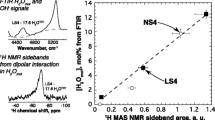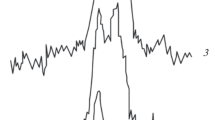Abstract
Infrared and near-infrared transmission spectra have been taken on 19 volcanic and synthetic silicate glasses with known H2O contents (0.06–6.9 wt. %). Absorption peaks were observed at wavelengths of 1.41 μm, 1.91 μm, 2.22 μm, 2.53 μm, and 2.8 μm. These peaks have been attributed to the first overtone of the OH stretching vibration, the combination stretching+bending mode of H2O molecules, the combination stretching+bending mode of X-OH groups, a combination mode of the fundamental OH stretch+a low energy lattice vibration, and the fundamental OH stretching mode, respectively. Molar absorptivities of the peaks have been determined to be 0.2, 1.8, 1.0, 0.9, and 67 l/mol-cm. These values apply over the full range of glass compositions studied (albite, rhyolite, basalt).
Quantitative determinations of total H2O contents and of the concentrations of molecular water and hydroxyl groups in silicate glasses are possible using these molar absorptivities, although they are limited in their accuracy by the accuracy of the reported water contents of the glasses used to calibrate these molar absorptivities. The most important uses of this technique may stem from its applicability to microsamples (≧100 μm) and to the determination of the concentrations of hydroxyl groups and molecular water in quenched silicate melts.
Hydroxyl groups are the dominant hydrogen-bearing species in water-bearing glasses at low total water contents, but molecular H2O was detected in all samples with ≧0.5 weight percent total water. The concentration of hydroxyl groups increases rapidly with total water content at low total water contents, but more slowly at higher (>3 wt. %) total water contents; it may level off or even decrease at high total water contents. The concentration of molecular water increases slowly at low total water contents and more rapidly at high total water contents. More water is dissolved as molecular water than as hydroxyl groups at total water contents greater than ∼4 wt. %. Molecular water in these glasses is probably structurally bound rather than present as fluid inclusions as a separate phase, since ice bands were not observed in spectra taken at 78K and since samples were free of visible bubbles.
It is proposed that the speciation of water in silicate glass formed by rapid quenching from melt equilibrated at high temperatures reflects that of the melt. According to this hypothesis, neither high water contents nor high pressures are needed to stabilize substantial quantities of molecular water in melts. This hypothesis, that water dissolves in silicate melts as both molecular water and hydroxyl groups in proportions similar to those measured in waterbearing glasses, can explain the variations in viscosity, electrical conductivity, diffusivity of “water”, diffusivity of cesium, and phase relationships that are observed in melts as functions of total water content. It also explains the observation that at vapor-saturation at high pressures, where most of the dissolved water is expected to be present as molecular water, water solubilities are similar for all melts but that at low pressures and water contents, where most dissolved water is present in dissociated form as hydroxyl groups, vapor-saturated water solubilities differ for different melt compositions. The linear relationship between water fugacity and the square of the mole fraction of total dissolved water observed for silicate melts at low water contents and the observed deviations from this linear relationship at high total water contents can be accounted for by this hypothesis.
Similar content being viewed by others
References
Bartholomew RF, Schreurs JWH (1980) Wide-line NMR study of the protons in hydrosilicate glasses of different water content. J Non-Cryst Sol 38&39:679–684
Bartholomew RF, Butler BL, Hoover HL, Wu CK (1980) Infrared spectra of a water-containing glass. J Am Ceram Soc 63:481–485
Bell PM, Mao HK, Weeks RA (1976) Optical spectra and electron paramagnetic resonance of lunar and synthetic glasses: A study of the effects of controlled atmosphere, composition, and temperature. Proc Lunar Sci Conf 7th, pp 2543–2559
Bottinga Y, Weill DF (1972) The viscosity of magmatic silicate liquids: A model for calculation. Am J Sci 272:438–475
Buerger MJ (1948) The structural nature of the mineralizer action of fluorine and hydroxyl. Am Mineral 33:744–746
Burnham CW (1963) Viscosity of a water-rich pegmatite melt at high pressure. Geol Soc Amer Spec Pap 76:26
Burnham CW (1975) Water and magmas; a mixing model. Geochim Cosmochim Acta 39:1077–1084
Burnham CW (1979) The importance of volatie constituents. In: HS Yoder Jr (ed) The evolution of the igneous rocks: Fiftieth Anniversary Perspectives. Princeton Univ Press, pp 439–482
Burnham CW, Davis NF (1971) The role of H2O in silicate melts. I. P-V-T relations in the system NaAlSi3O8-H2O to 10 kilobars at 1,000° C. Am J Sci 270:54–79
Burnham CW, Davis NF (1974) The role of H2O in silicate melts. II. Thermodynamic and phase relations in the system NaAl-Si3O8-H2O to 10 kilobars and 1,000° C. Am J Sci 274:902–940
Delaney JR, Karsten JL (1981) Ion microprobe studies of water in silicate melts: concentration-dependent water diffusion in osidian. Earth Planet Sci Lett 52:191–202
Dodd DM, Fraser DB (1966) Optical determinations of OH in fused silica. J Appl Phys 37:3911
Eggler DH, Rosenhauer M (1978) Carbon dioxide in silicate melts: II. Solubilities of CO2 and H2O in CaMgSi2O6 (diopside) liquids and vapors at pressures to 40 kb. Am J Sci 278:64–94
Ernsberger FM (1977) Molecular water in glass. J Am Ceram Soc 60:91–91
Goldman DS, Rossman GR, Dollase WA (1977) Channel constitutents in cordierite. Am Mineral 62:1144–1157
Hamilton DL, Burnham CW, Osborn EF (1964) The solubility of water and effects of oxygen fugacity and water content on crystallization in mafic magmas. J Petrol 5:21–39
Harris DM (1981a) The microdetermination of H2O, CO2, and SO2 in glass using a 1,280° C microscope vacuum heating stage, cryopumping, and vapor pressure measurements from 77 to 273 K. Geochim Cosmochim Acta 45:2023–2036
Harris DM (1981b) The concentration of CO2 in submarine tholeiite basalts. J Geol 89:689–701
Hodges FN (1973) Solubility of H2O in forsterite melt at 20 kbar. Carnegie Inst Washington Yearb 72:495–497
Hodges FN (1974) The solubility of H2O in silicate melts. Carnegie Inst Washington Yearb 73:251–255
Huggins ML (1940) The density of silicate glasses as a function of composition. J Opt Soc Am 30:420–430
Hunt GR, Salisbury JW (1970) Visible and near-infrared spectra of minerals and rocks: I. Silicate minerals. Modern Geology 1:283–300
Hunt GR, Salisbury JW, Lenoff CJ (1971) Visible and near-infrared spectra of minerals and rocks: III. Oxides and hydroxides. Modern Geology 2:195–205
Jambon A (1979) Diffusion of water in a granitic melt: an experimental study. Carnegie Inst Washington Yearb 78:352–355
Jambon A, Carron JP, Delbove F (1978) Données préliminaires sur la diffusion dans les magmas hydratés: le cesium dans un liquide granitique à 3 kbar. CR Acad Sci D 287:403–406
Kats A (1962) Hydrogen in alpha-quartz. Philips Res Repts 17:201–279
Kurkjian CR, Russell LE (1958) Solubility of water in molten alkali silicates. J Soc Glass Techn 42:130T-144T
Kushiro I (1975) On the nature of silicate melt and its significance in magma genesis: regularities in the shift of the liquidus boundaries involving olivine, pyroxene, and silica minerals. Am J Sci 275:411–431
Lebedev EB, Khitarov NL (1964) The dependence of electrical conductivity of granite melt and the beginning of granite melting on high pressure of water. Geochimiya 3:195–21
Moulson AJ, Roberts JP (1960) Water in silica glass. Trans Brit Ceram Soc 59:388–399
Mysen BO (1977) The solubility of H2O and CO2 under predicted magma genesis conditions and some petrological and geophysical implications. Rev Geophys Space Phys 15:351–361
Mysen BO, Virgo D (1980) Solubility mechanisms of water in basalt melt at high pressures and temperatures: NaCaAlSi2O7-H2O as a model. Am Mineral 65:1176–1184
Mysen BO, Virgo D, Harrison WJ, Scarfe CM (1980) Solubility mechanisms of H2O in silicate melts at high pressures and temperatures: a Raman spectroscopic study. Am Mineral 65:900–914
Nakamoto K, Margoshes M, Rundle RE (1955) Stretching frequencies as a function of distances in hydrogen bonds. J Am Chem Soc 77:6480–6486
Orlova GP (1962) The solubility of water in albite melts. Int Geol Rev 6 (1964):254–258
Ostrovskiy IA, Orlova GP, Rudnitskaya YS (1964) Stoichiometry in the solution of water in alkali-aluminosilicate melts. Doklady Akad Nauk SSR 157:149–151
Pearson AD, Pasteur GA, Northover WR (1979) Determination of the absorptivity of OH in a sodium borosilicate glass. J Mat Sci 14:869–872
Riebling EF (1968) Structural similarities between a glass and its melt. J Am Ceram Soc 51:143–149
Russell LE (1957) Solubility of water in molten glass. J Soc Glass Tech 41:304–317T
Scholze H (1959) Der Einbau des Wassers in Gläsern. Glastech Ber 32:81–88, 142–145, 278–281
Scholze H (1960) Zur Frage der Unterscheidung zwischen H2O-Moleceln und OH-Gruppen in Gläsern and Mineralen. Naturwiss 47:226–227
Scholze H (1966) Gases and water in glass. Glass Ind 47:546–551, 622–628
Seifert FA, Mysen BO, Virgo D (1981) Structural similarity of glasses and melts relevant to petrological processes. Geochim Cosmochim Acta 45:1879–1884
Sharma SK, Virgo D, Mysen BO (1978) Structure of glasses and melts of Na2O·xSiO2 (x=1, 2, 3) composition from Raman spectroscopy. Carnegie Inst Washington Yearb 77:649–652
Shaw HR (1963) Obsidian-H2O viscosities at 1,000 and 2,000 bars in the temperature range 700°–900° C. J Geophys Res 68:6337–6343
Shaw HR (1964) Theoretical solubility of H2O in silicate melts: quasi-crystalline models. J Geol 72:601–617
Shaw HR (1974) Diffusion of H2O in granitic liquid. I. Experimental data. II. Mass transfer in magma chambers. In: AW Hofmann, BJ Giletti, HS Yoder Jr, RA Yund (eds) Geochemical transport kinetics. Carnegie Inst Wash Publ 634:139–170
Stephenson GW, Jack KH (1960) Written discussion on paper by Moulson and Roberts. Trans Brit Ceram Soc 59:397–399
Stolper E (1982) The speciation of water in silicate melts. Geochim Cosmochim Acta (in press)
Stone J, Walrafen GE (1982) Overtone vibrations of OH groups in fused silica optical fibers. J Chem Phys 76:1712–1722
Sweet JR, White WB (1969) Study of sodium silicate glasses and liquids by infrared spectroscopy. Phys Chem Glasses 10:246–251
Takata M, Acocella J, Tomozawa M, Watson EB (1981) Effect of water content on the electrical conductivity of Na2O·3SiO2 glass. J Am Ceram Soc 64:719–724
Taylor M, Brown GE Jr, Fenn PM (1980) Structure of mineral glasses — III. NaAlSi3O8 supercooled liquid at 805° C and the effects of thermal history. Geochim Cosmochim Acta 44:109–117
Tomlinson JW (1956) A note on the solubility of water in a molten sodium silicate. J Soc Glass Tech 40:25–31T
Toop GW, Samis CS (1962) Activities of ions in silicate melts. Trans Met Soc AIME 224:878–887
Uys JM, King TB (1963) The effect of basicity on the solubility of water in silicate melts. Trans Met Soc AIME 227:492–500
Wasserburg GJ (1957) The effects of H2O in silicate systems. J Geol 65:15–23
Watson EB (1979) The effect of dissolved water on cesium diffusion in molten granite. EOS 60:402
Watson EB (1981) Diffusion in magmas at depth in the earth: the effects of pressure and dissolved H2O. Earth Planet Sci Lett 52:291–301
Williams JP, Su Y-S, Strzegowski WR, Butler BL, Hoover HL, Altemose VO (1976) Direct determination of water in glass. Ceramic Bull 55:524–527
Wu CK (1980) Nature of incorporated water in hydrated silicate glasses. J Am Ceram Soc 63:453–457
Author information
Authors and Affiliations
Rights and permissions
About this article
Cite this article
Stolper, E. Water in silicate glasses: An infrared spectroscopic study. Contr. Mineral. and Petrol. 81, 1–17 (1982). https://doi.org/10.1007/BF00371154
Received:
Accepted:
Issue Date:
DOI: https://doi.org/10.1007/BF00371154




